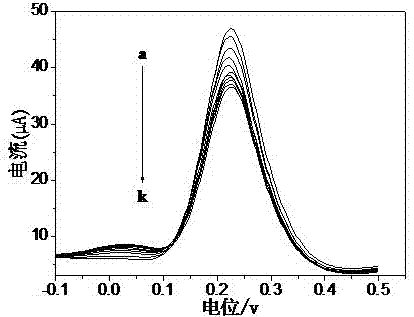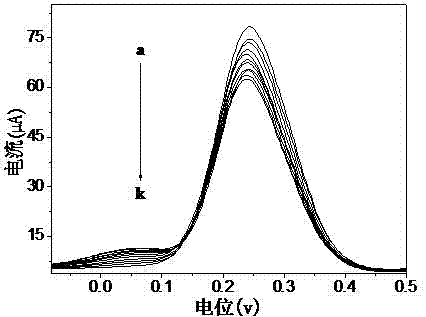Application of electrochemical immunosensor in detection of multi-residue of sulfonamide medicines
A technology of sulfonamide drugs and immunosensor, which is applied in the field of food safety detection and analytical chemistry, can solve the problems of complex sample processing, inability to simultaneously detect multiple or high-throughput screening of a class of compounds, and achieve simple sample pretreatment, The effect of fast detection speed and low cost
- Summary
- Abstract
- Description
- Claims
- Application Information
AI Technical Summary
Problems solved by technology
Method used
Image
Examples
Embodiment 1
[0023] Example 1 Preparation of electrochemical immunosensor
[0024] The glassy carbon electrode is pretreated and cleaned first, and then 6 µL of graphene-chitosan solution is drip-coated on the surface of the treated glassy carbon electrode, placed in a 37°C incubator to dry, and then 10 µL of sulfadiazine is drip-coated Put it on the electrode, dry it in an incubator at 37°C, and perform DPV detection respectively; finally insert the electrode into 500 microliters of 0.5% BSA solution and seal it for 40~50mim to obtain an electrochemical immunosensor modified by sulfadiazine / graphene-chitosan .
Embodiment 2
[0025] Example 2 Detection of sulfadiazine (SD)
[0026] Prepare the electrochemical immunosensor modified by sulfadiazine / graphene-chitosan by the method of Example 1, and immerse it in a total volume of 50 μL of PBS containing 8 μL of sulfadiazine antibody and a series of different concentrations of sulfadiazine standard solution Incubate in a 37°C incubator for 40 min in the incubation solution, wash with PBS after incubation, and then in 2 mmol / L K 3 [Fe(CN) 6 ] in the KCl solution (0.1mol / L) for DPV scanning, respectively record the peak current I at different concentrations, the DPV curve is as follows figure 1 As shown, the concentration of the graph from top to bottom is 1000 ng / mL, 300 ng / mL, 100 ng / mL, 30 ng / mL, 10 ng / mL, 3 ng / mL, 1 ng / mL, 0.3 ng / mL mL, 0.1 ng / mL, 0.03 ng / mL, and 0.01 ng / mL. When the concentration to be detected is defined as zero, the peak current value is I 0 , ΔI is the difference between the peak current of the detection sample and the peak c...
Embodiment 3
[0027] Example 3 Detection of sulfaguanidine (SG)
[0028] Prepare the electrochemical immunosensor modified by sulfadiazine / graphene-chitosan by the method of Example 1, and immerse it into the PBS containing 8 μL of sulfadiazine antibody and a series of different concentrations of sulfaguanidine standard solution with a total volume of 50 μL Incubate in a 37°C incubator for 40 min in the incubation solution, wash with PBS after incubation, and then in 2 mmol / L K 3 [Fe(CN) 6 ] in the KCl solution (0.1mol / L) for DPV scanning, respectively record the peak current I at different concentrations, the DPV curve is as follows image 3 As shown, the concentration of the graph from top to bottom is 1000 ng / mL, 300 ng / mL, 100 ng / mL, 30 ng / mL, 10 ng / mL, 3 ng / mL, 1 ng / mL, 0.3 ng / mL mL, 0.1 ng / mL, 0.03 ng / mL, and 0.01 ng / mL. When the concentration to be detected is defined as zero, the peak current value is I 0 , ΔI is the difference between the peak current of the detection sample an...
PUM
 Login to View More
Login to View More Abstract
Description
Claims
Application Information
 Login to View More
Login to View More - R&D
- Intellectual Property
- Life Sciences
- Materials
- Tech Scout
- Unparalleled Data Quality
- Higher Quality Content
- 60% Fewer Hallucinations
Browse by: Latest US Patents, China's latest patents, Technical Efficacy Thesaurus, Application Domain, Technology Topic, Popular Technical Reports.
© 2025 PatSnap. All rights reserved.Legal|Privacy policy|Modern Slavery Act Transparency Statement|Sitemap|About US| Contact US: help@patsnap.com



